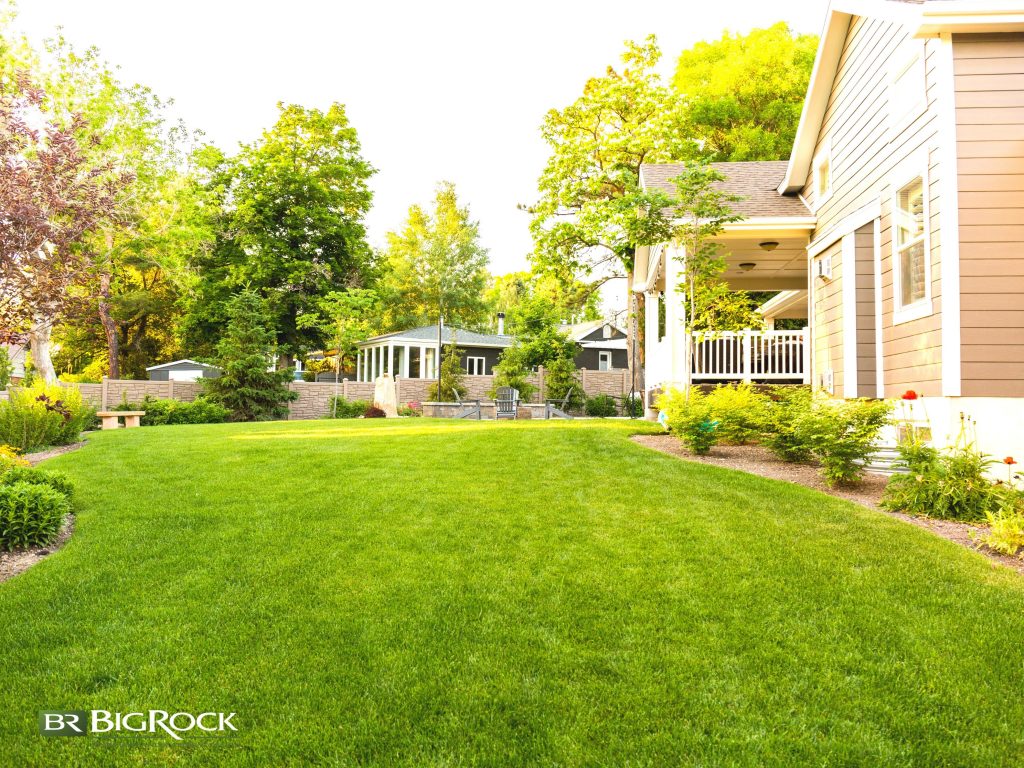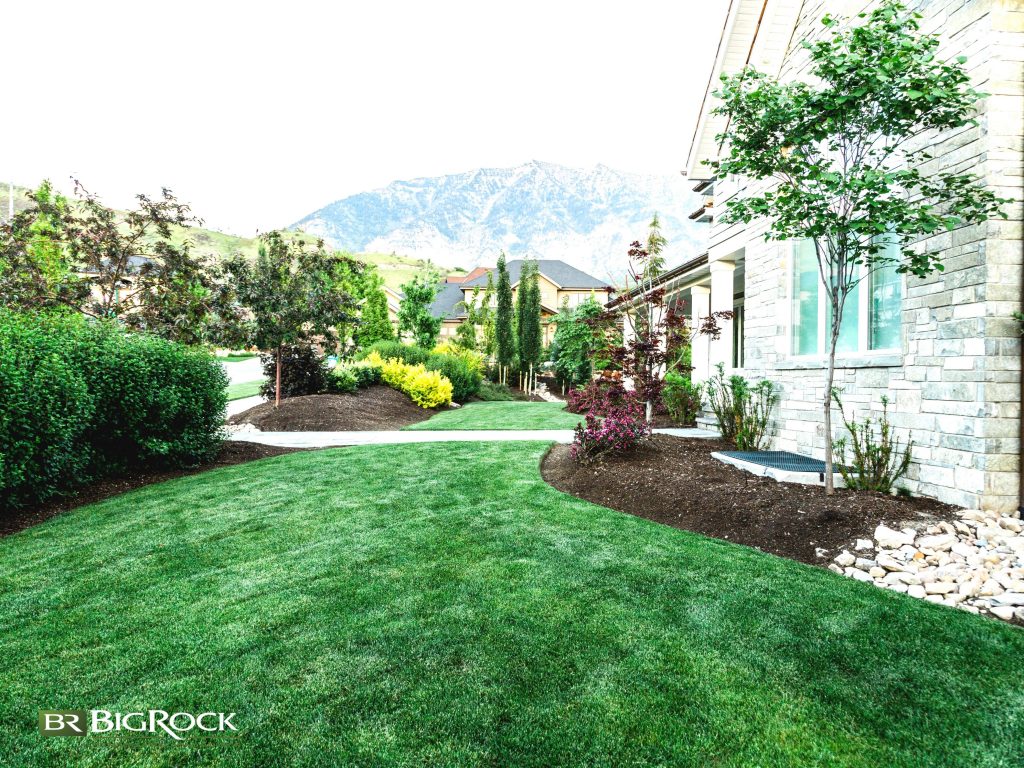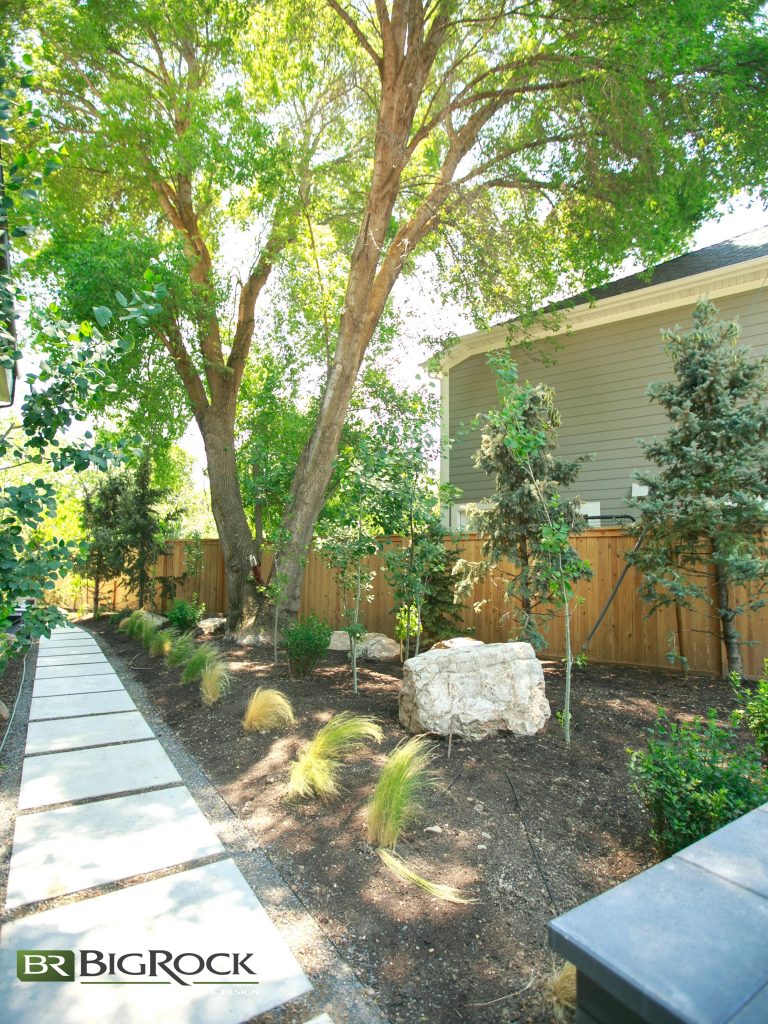
7 Things To Do For Your Yard This Fall
Fall is the season that seems to come and go in the blink of an eye every year. It rarely feels like there is enough time to get your bucket list of festive activities done, let alone take care of your yard! But with these simple yard tips for fall, you’ll have your lawn shedding the weight of a harsh summer and prepped for the first real frost in no time!
Why Fall Yard Maintenance Is Important
After a summer of unchecked sunshine and scorching temperatures, backyard badminton tournaments, and a series of questionable haircuts from that newfangled lawnmower, your yard is begging for some end-of-summer yard care before winter strikes.
Fall yard maintenance is super important for a few reasons. Did you know that all that summer heat and wear can compact your yard’s topsoil and make it difficult for new grass to grow and flourish come spring? High temperatures can also deplete nutrients in the soil which is the perfect environment for weeds and pests to conquer weakened grassroots, making for a patchy, uneven lawn. And if you don’t remove the bulk of those lovely autumnal leaves, you may be looking at a dead or fungus-ridden lawn when the snow finally melts off.
Because your lawn takes a lot of abuse during summer, and even as the leaves start falling, you need to combat those negative effects, as well as prep for winter, with a smart fall grass care routine. It’s easy to assume that once the heat isn’t scorching your lawn, it’s done growing and can be more or less ignored until the next summer, but that couldn’t be further from the truth.
In fact, the fall is one of the most impactful times for your lawn, where you can make or break your spring and summer lawn next year. Even though the temps are lower in the fall months, your lawn is still growing. In fact, most Utah lawns prefer cooler temps for growing, usually between 60 and 75 degrees. Lawns don’t go dormant until daytime temps drop below 50 degrees, so they still need TLC as well as winter prep in the fall.

7 Fall Landscaping Tips For Your Yard
Following these 7 easy yard tips for fall will help you ensure your yard can take the worst winter has to offer and come out looking stronger and even more beautiful next spring!
Consider Aerating
Our first yard tip for fall? Aeration. Every couple of years it’s a good idea to loosen up your soil and break up any underlying thatch—that obnoxious layer of tangled roots and debris that can block sunlight, water, and nutrients from reaching your grass’ roots. This can be done to varying degrees of effectiveness with things like spiked footwear to more sophisticated machine methods that pull plugs from the lawn, allowing your stressed turf some room to breathe.
Seed & Fertilize Your Lawn
If you have a thin lawn or any dead spots from this summer’s fun (we’re looking at you, plastic kiddie pool!), fall is a great time to overseed your grass. Just make sure the seeds actually hit soil or they’ll never germinate and your efforts will be in vain. Once you’ve got seeds down, fall is the absolute most important time to apply an appropriate fertilizer (testing your soil will tell you which nutrients your lawn is begging for). Doing this will be the foundation for a thicker, stronger lawn in the springtime, especially if you’ve just aerated!

Give The Grass One Last Cut
Keeping your grass at a regular length before winter is another important one of our yard tips for fall. We suggest keeping grass between about 2.5”-3”—any longer and your lawn is at risk formatting and creating a great environment for damaging molds. Any shorter and you can curtail the root system, leaving blades too short to properly photosynthesize and feed the roots. Cutting your grass through fall can also help manage the falling leaves.
Take Care Of The Leaves
Speaking of which, your fall yard care checklist has to include removing leaves from the grass (unless they’ve been broken up into mulch by your lawnmower) so they don’t suffocate or rot the grass during long winter months. Make sure you don’t ignore corners and fencelines where leaves tend to gather after a windy autumn day!
Mulch Your Trees & Shrubs
Mulch can help maintain soil fertility and moisture, providing necessary nutrients and sustaining life during long winter months. It can also act as an insulating barrier for plant roots against harsh winter conditions. And if you get to this part of your fall landscaping maintenance soon enough, you can enjoy the visual refresh that turning the existing mulch or adding fresh mulch can offer your yard.

Do Some Planning, Planting, & Pruning
Believe it or not, one of our yard tips for fall is actually to consider actually planting flowers or shrubs. It may mean swapping out summer annuals for some fall blooms or even rearranging your perennial garden, but either way, fall is a great time to add life to your landscaping. It’s also an important time to prune trees and shrubs to prevent wintertime damage. Just make sure to do your research first—pruning is a plant-specific science and you may end up ruining spring-flowering if you attack the wrong plant or the right plant the wrong way.
Give Your Hardscape Some TLC
Ignoring your hardscape is a big no-no when it comes to getting your yard ready for fall. Now is a good time to seal any cracks in walkways or your driveway as water can pool here and then freeze, putting you at risk for even more damage than you see now.
Care For Your Fall Blooms
There are a few plants that show off in the fall—think sunflowers and oakleaf hydrangea (they turn a deep maroon or red in the fall). Make sure you are watching for weather that might damage these late bloomers, like heavy wind, rain, or cool temperatures.
Bonus Tip: Pack Up For Winter
Remember when your mom used to say that the dishes weren’t done if the drying towel wasn’t put away? (No, only mine?) Well, consider your fall lawn care not done if you haven’t packed up your gardening tools and hoses, and properly winterized your sprinkler or irrigation lines.
Winterize Your Irrigation System
Equipment Needed:
- A simple sprinkler adapter for blow-out
- 4-6 gallon air compressor
- A hose long enough to reach from the sprinkler control valve to the compressor
Step-By-Step Irrigation System Winterizing
- Winterize your irrigation system in Utah BEFORE the first frost
- Turn off the water
- Turn off any timers you have set
- Drain the water
- Compression blow-out
- Automatic draining or
- Manual draining
- Insulate above-ground components (shut-off valve, exposed pipes, backflow preventers, etc.)
Preparing Tools For Winter
Lawn Mower Storage
Ensuring your lawn mower is prepped for winter is one of the most important tasks in preparing your landscaping tools for winter. Not only will preparing your mower for winter give your lawnmower many seasons of cutting grass, but it is a safety issue as well. For example, lawnmowers with improperly stored fuel can cause fires, so emptying your fuel completely or adding a fuel stabilizer is a matter of safety.
- Drain the oil and drop it off at your local hazardous-waste facility
- Make sure there are no missing O-rings on the gas caps–they help protect against dust and moisture
- Replace the fuel filter
- Clean the spark plug
- If you have fuel in your lawnmower, poor in some fuel stabilizer–this will keep the fuel fresh for about six months.
- Clear away any remaining dust and dirt.
Fall Garden Tool Storage
While it may seem like an unnecessary step, caring for your tools before the winter makes sure the tools are safe and last for years to come. Cleaning your tools will ensure bacteria and pests don’t grow, sharpening your tools will help you avoid injury and are better for your plants, and oiling your tools adds years to their use.
- Clean: wipe soil off of any blades, and use a stiff nylon brush with water and mild soap for the handles
- Sharpen: for larger blades, use a whetstone; use a small hand-held sharpener for smaller blades.
- Protect: use a thin layer of protective oil to coat the blades and store them in the garage or a shed.
Fall Yard Pest Control Tips
When it comes to pest control, as with most things, an ounce of prevention is worth a pound of cure. To help your yard stay clear of voles and mice, make sure to keep your yard pruned and cut. Trim shrubs and bushes up and away from the ground to prevent voles and mice from hiding and making habitats, and add mesh protection around the bases of trees and shrubs.
Make sure you clean out your garden beds, especially those where you have grown food to ensure your crops don’t become dinner for mice and other rodents in the area. In fact, keeping debris of any kind clear from your yard helps keep other pests away, like spiders, ants, cockroaches, aphides and slugs away. After all, those tiny crawlers like to live in damp, dark, undisturbed places, which is exactly what your yard will become if you don’t rake leaves, clean up plants, and throw away gardbage. If you have an especially bad bug infestation, you can use a natural pesticide to remove the bugs before they overtake the yard.
FAQs About Fall Landscaping In Utah
When is the best time to start fall landscaping in Utah?
In September, it’s time to decrease how much you water your lawn and plants and aerate your lawn. You’ll also want to plant new shrubs, evergreens, and fall annuals at this time. Schedule a day and time to have your irrigation system winterized before the first frost arrives.
Drain and winterize your sprinkler system in October before a hard frost occurs. Remove perennials, rake up leaves, and plant spring bulbs. And clean out those rain gutters!
What are some ideal fall plants for landscaping in Utah?
Here are some of our favorite plants that bring color and life to your yard during the fall season in Utah:
- Plumbago
- Chokeberry
- Oakleaf Hydrangea
- Bluebeard
- Zelkova Tree
- Scarlett Regal Petticoat Maple
How should I prepare my lawn for the Utah winter during the fall season?
- Decrease how much and how often you water your lawn as fall arrives
- Schedule irrigation winterization for sometime in October or before the first frost
- Aerate your lawn
- Rake up all leaves and any other debris
- Fertilize your lawn–usually in early November
What can I do to protect my plants from early frosts in Utah during the fall?
- Mulching: mulch acts as a natural insulator and helps regulate soil temperature and retain moisture
- Fertilize your plants with a low-nitrogen, high-phosphorus fertilizer
- Decrease watering
Are there any fall pests or diseases I should watch out for in Utah?
As winter approaches and colder temperatures arrive, insects start to die off. However, it’s common for squirrels to begin storing pine cones in unwanted places, such as crawl spaces and underneath decks. Keep an eye on these places, as pine cones obstruct sump-pumps and other flooding precautions.
It’s common for deer to begin to come down to lower elevations as their food supply decreases. Depending on your location, this may or may not affect your yard in the fall and winter months.
What are the benefits of mulching in Utah during the fall season?
Mulch acts as a natural insulator and helps regulate soil temperature and retain moisture. This helps protect plants from early frosts.
Can I plant trees and shrubs in the fall in Utah?
Yes! Fall time is a great time to plant new trees and shrubs. You’ll want to plant them at least six weeks before the first frost and choose burlap-wrapped or container-grown trees. Here are a few of the best trees and shrubs to plant in fall in Utah:
- Maples
- Spruces
- Pines
What should I do with my fall leaves in Utah?
One of the best things for your soil is leaves! But don’t just leave them sitting on your lawn. Use them as compost and mulch. Here are some great ways to use leaves to enrich your soil in Utah:
- Mix shredded leaves into your garden
- Make leaf mold and mulch
- Create a compost pile; turn the pile occasionally to aerate it
- Mow leaves into the lawn
- Cover cold-hardy vegetables (such as carrots and potatoes) as an insulating layer.
What’s the best fertilizer mix for Utah lawns in fall?
Overall, you want to look for a slow-release fertilizer that will give your lawn the nutrients it needs to survive months of cold temperatures and snowfall. You also want to make sure your fertilizer has potassium, as this nutrient helps protect the plant from cold. A moderate amount of nitrogen is important as well, as this gives the lawn its green color. Make sure it isn’t too much nitrogen, as this can stress dormant plant.
Should I water my lawn in the fall, and if so, how often?
Yes! Watering in the fall is important, as it helps the plant survive winter conditions. When temperatures get between 70-80 degrees, water 2-3 times a week, and when it drops below 70 water once a week. When daytime temperatures hit 50 degrees, you can stop watering and get your sprinkler system prepped for winter.
What are some effective ways to deal with fall weeds?
First, remove any visible weeds and keep up on that removal process, weeds can get out of hand fast even in the fall. Then, apply a pre-emergent herbicide, which will prevent weeds from germinating in the spring.
Need Help With Your Fall Yard Maintenance?
We don’t expect everyone to be an expert on yard maintenance—even with these easy yard tips for fall—which is why Big Rock Landscaping is here to help with your lawn and landscaping maintenance needs this fall! Not only do we offer landscape design and installation services, but we expertly maintain many residential and commercial properties along the Wasatch Front. It is easy to see why we are the best choice for your landscaping needs:
- We’ve won multiple awards for our customer service
- Combined decades of experience
- Experts in Utah’s unique climate and landscaping needs
- Obsessed with landscape design and maintenance
We have the talent, the tools, the attention to detail, and the unparalleled customer service you’ll want in a landscape maintenance company, and we’re dedicated to ensuring that your yard is properly cared for in every season. We’re an award-winning company for our service, with combined decades of experience, and expertise in Utah’s unique climate and landscape needs.
Contact us to schedule our fall yard care services today.


Leave a Reply
You must be logged in to post a comment.